
Neck Sharpies: Four Duos to a Trophy

I apologize for this taking awhile to get out but gravity hasn’t been functioning properly since last Monday night, and it’s hard to type when your feet won’t touch the ground. I was also trying to wrap my head around all of the parts of Michigan’s pass defense to show you, until I realized that’s going to require an entire UFR (that and the Rose Bowl one forthcoming).
So let’s do something simple that you can show your friends and relatives for equal enjoyment, that being the Michigan run game that blew a big enough hole in the Washington defense to drive a national championship parade through it.
The star of the Michigan running game, once again, was Duo, the Schembechler favorite that Harbaugh re-popularized in the middle teens. This was foreseeable. Washington has weak DTs and linebackers prone to big mistakes they can’t fix with Alabama LB athleticism. Even without Zak Zinter, Michigan has an experienced, large, mashing offensive line. But to really make it work against Washington, they had to have so much more. And while these plays are probably already being talked to death, when we talk about Michigan’s offense, we ought to understand how much value all of these parts are bringing to a running game that won them the Championship.
[AFTER THE JUMP: Big runs]
DEFENDING DUO
We’ve been going on about Michigan’s favorite running play since they blew out Penn State with it in 2016. Duo is Inside Zone except with extended double teams on the DTs.
The linebackers behind them are waiting to see which gap to attack, but then the double-team goes so well that they have to make a decision before the running back does. Here is an excellent example of Duo being used to win a national championship.
Moving the NT and DT with those doubles puts the linebackers behind them in a bind because the thing they can't do is get stuck behind the guy getting doubled. The RB's job is to make sure that happens by catching the LB's eye, pressing one side of a working double to force the LB to commit to that side of it, then bouncing to the other side. It looks like inside zone, and can act like inside zone too. In fact if the guy being doubled gets put outside of the double, your linemen are expected to release and pick off the linebacker just as they would on inside zone. That ultimately happens on both of the doubles in the play above.
If you have the kinds of blockers who can reliably move their defenders and the kind of running back who can reliably press one gap then explode to another, you have the tools to be good at Duo.
SPIKING DUO
If you use Duo a lot, and your opponent doesn’t have the tools to stop you, they’re going to be ready to mess with you. The most surefire way to do that is to have the linebackers fly into those doubles, effectively making them into linemen and stuffing all of the gaps that Duo can threaten. That’s great if you can spare the linebackers from coverage; TCU and Illinois got away with it in 2022 because Michigan was loathe to run play-action as much as they should. When opponents tried it this year they bought Roman Wilson another touchdown.
Another way to deal with it, if you’re expecting Duo, is to move those gaps further apart. This was Penn State’s gambit: to have the linemen “Spike” their gaps, getting inside and up. Notice the end on the outside left and the linebacker talking to him. Their switch pushes the outside gap that Corum is threatening to the left of Bredeson. With defenders pushing backwards, it’s a hard gap to get to.
If Henderson and Zinter get their linebackers there's nobody until the safety. The penetration doesn't matter because Corum is leaving the backfield before any of them are in any shape to make a tackle. And the linebackers can't just bury themselves in any of these gaps to make things right because there are simply too many gaps. The only guy able to act like a normal linebacker is the quasi-LB coming inside Bredeson on the far left.
The Washington version of this wasn't as insane. Their plan, which is also the Michigan defense's plan against this stuff, was to have the defensive linemen getting doubled fight across the double. This comes off like a surrender, but it's not. With nobody to block anymore, the backside doubler has to move onto the linebacker, who now knows exactly which lane to go. Also once the double has ended, the defensive lineman is free to fight back to where he was before. If we zoom in on our first example, we can see the Huskies' plan.
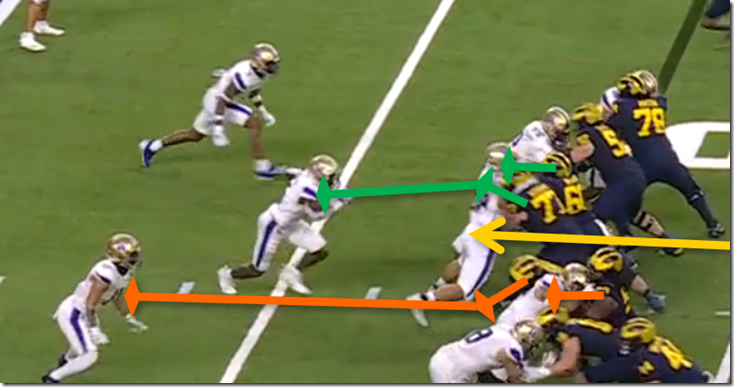 Henderson's side of the double is superfluous as the DT is fighting upfield and outside of Trente Jones. A similar thing is happening with the nose that Keegan and Nugent are doubling, except in their case the linebacker is already activating so Keegan has to deal with him.
Henderson's side of the double is superfluous as the DT is fighting upfield and outside of Trente Jones. A similar thing is happening with the nose that Keegan and Nugent are doubling, except in their case the linebacker is already activating so Keegan has to deal with him.
It's a mess in there, but we can see as soon as those doublers moved on their linemen stopped being Penn State berzerkers and started fighting back across their now-singled blockers.
ANSWERS TO THE ANSWERS
With any football concept, when the opponent starts doing something to stop you, you can always go to some kind of counter to punish what they’re doing. But that just gets you into a game of rock-paper-scissors. Better to use your advantages to play an unfair game you’re going to win.
One way that Michigan managed to get their Duo blocks was to have them appear where the defense wasn’t expecting them. Typically you’re moving DTs with your linemen, but that doesn’t have to be the block. When they were running this stuff in the middle of the 20th century the inline tight ends were regular participants. The trouble with doing that in 2023 is the DTs are so big that it’s hard for a tight end to get much movement. If you can get a TE/OT combo on a defensive end that works, except defensives usually won’t put their DEs inside those doubles unless they can hold up.
Michigan had a clever way to get that matchup on the first drive, when they pulled a TE from the opposite edge and had him join a Duo block. Watch Colston Loveland coming down the formation:
It looks like a Split Zone with Loveland coming across to kick out the end man on the line of scrimmage. That’s going to be the WLB, since the DE they’re doubling is spiking what would have been the backside B gap between the LT and LT, and the WLB is making him right by hopping outside.
The trick is getting that DE moved so far inside that the WLB has to give up yards to track the RB down in space. He thinks his job is to wait until Loveland’s kickout block has no momentum then fling himself up to cut off that escape.
In truth he’s the guy responsible for tackling Corum, while Loveland is adding to Henderson’s block on the spiking DE #8. That DE even does a good job of holding up, but the athletic advantage that Corum has over the WLB in space equals yards once he threatens outside then puts his foot in the ground and goes upfield.
It’s a solid gain, but if that guy whiffs it’s a touchdown. And it wouldn’t be long until Washington cracked.
THE FIRST EDWARDS TOUCHDOWN
This play is mostly a gift from the free safety and the DT.
Again, Michigan is trying to move to Duo blocks over to the DE and DT, leaving Barnhart to try to cut off the nose. As far as Edwards is concerned, he's got to get the WLB to commit to a gap behind the DT. A fake RPO mesh from McCarthy holds the backside defenders from interfering with the run. The WLB is activating because Nugent is releasing, which Nugent's doing because he saw the playside DT go to the gap to the other side of Keegan. As long as Barnhart gets the backside DT controlled they have a lane behind Nugent.
Way over to the left, Henderson had a kick step back that got the DE to come upfield, giving Barner leverage to kick him wide and create more space for a bounce.
With the WLB activating at an interior gap and the cornerback having to replace inside the DE, there's a gap forming that the playside DT is closing. A back with better vision than Edwards might notice the nose is crossing Barnhart and try that backside B gap, but Edwards isn't judging Barnhart's block; he's reading Nugent's butt and sees a lane forming in the frontside A gap and wants to hit it before Barnhart loses to the nose.
This doesn't work. The playside DT crosses Keegan, the nose got fully across Barnhart, and Edwards is running right at the DTs converging behind Nugent. If they were coached to do that it's dangerous, but it does mess with the way Michigan is trying to run Duo. Instead of doubling the DTs, those DTs are pinching the gap Edwards thought he was getting through.
Theoretically, a help defender should be coming to catch a bounce from this. The MLB was held by the RPO but is on his way to the gap the nose abandoned. The WLB is hidden behind the nose, stuck to the backside of Nugent. On the left, the cornerback should be able to dodge Henderson and come up to fill where the playside DT abandoned. Defenses that trust their DTs to be superstars play this way, but if they're going to be reactive the guys behind them have to make them right.
What started as an attempt to undo Michigan's preferred blocking has gone silly. If it works however the DTs both get gold stars for crossing their blockers and stuffing Edwards behind the line of scrimmage. Edwards's mistake was to come so far down that the DTs could act so aggressively and come in contact with him. That mistake works out for Michigan, however, because his certain doom draws the free safety down.
And down.
And down.
The clusterfu this turned into disguises the more interesting play and response. Michigan designed this to attack the WLB but Washington effectively flipped it from an unblocked linebacker to a single-blocked DT, which was a win for the defense until nobody could fit it correctly. It's hard to be mad at Edwards for not seeing it develop, especially since his overcommitment caused an overreaction from the safety that opened up space for Edwards to use his speed for all the yards.
I wanted to go over it though because even this was too complicated for Washington. And Michigan was about to make it a lot more complicated.
THE SECOND EDWARDS TOUCHDOWN
If Washington was having trouble fitting a standard array of gaps, look how messed up they got fitting extra ones.
They're trying to clog up the middle with a Bear front, with the linebackers reacting to the double-teams on both DTs. But they don't have enough players to keep re-gapping that way. Steal a WLB from the backside to make the nose right and there's nobody to make the backside T right.
Michigan did a similar thing to Penn State, whose strategy against Duo was to have the up-front defender "Spike" inside his gap with a linebacker moving around behind to make him right. Michigan just kept adding gaps until players were doing things they weren't recruited for, and the linebacker had too many gaps to keep track of. Look how many gaps we've got here!
Ten places to go, and Washington's defenders did not have a fancy color-coded graphic to keep track of them all. They did have enough players to fit them, but only if ten of eleven guys have a gap assignment. This turns all ten of those guys into front-seven players. Michigan has six offensive linemen, two tight ends, and Cornelius Johnson on the field, and Washington has matched with a 5-2 front. The free safety aligns over the side with the wide receiver but in position to assist in a run. That means the whole right side of this fit is mano-a-mano.
If you have defenders just staying in their gaps that's fine. But Washington's using that pinch method to spread the attackable gaps further apart. So the backside DT is going to cross Barnhart again and the WLB is supposed to flip gaps with him. Someone should tell him that?
This isn't supposed to go this well, but what's happening here is Michigan messing with the WLB's training. The guy sees the double on the DT in front of him and reacts the way he usually reacts when there's a seven-man box against a normal number of run blockers: Make my nose right. If the NT can't get across Keegan, the WLB seems to think it's his job to get there for him. It's actually the other LB's job, but Trente Jones is releasing on that LB and the run is coming down hard on the QB's left side.
B gap.
The rationale for such behavior is the defense wants to save a free hitter from the LB level to shadow the running back. If your DTs can get across their blocks regularly, theoretically you're giving the backs a tough read as DTs cut off the gap the RB's momentum is carrying him towards, and that delay gives the LB time to get to the gap the DT just abandoned. This WLB took the wrong lesson, however. It works when you're making one DT right, but you can't solve everything for both DTs.
Weirdly, this might have been the plan? If you look at the MLB, he's watching the double forming with Johnson and Bredeson on the left side as the DE to the strongside spikes the gap between Bredeson and Jones (53). If I had to guess what went wrong, Washington wanted their linebacker reacting aggressively to the running back and figured they would have a couple of defenders backside who could help fill on a cutback. We're not talking enough about how well Loveland played this, stalking the CB then flipping his hips and squaring himself to the gap the CB wanted to get back to.
I mean this is textbook. Kudos also to Barnhart for making sure there was zero chance of the DT that he and Nugent were doubling could get back across him. The lane is literally the hash mark to the numbers.
The lesson here is Washington could not play defense the way they wanted to.
Not that they were ready to stop trying.
THE BIG CORUM RUN
You guys!
So Michigan's being a little tricky here by flipping the jobs Washington's defenders, meaning the safeties who are having to play linebacker roles are going to be tested. Michigan State used a similar gambit on Michigan on their first drive of 2016, flipping the formation's strength with multiple guys in order to put Jabrill Peppers in a middle linebacker role.
When they originally lined up, Washington had the matchups they wanted: safetyish linebackers for Michigan's dual-threat tight ends, a true safety for Corum if he went in a pass pattern, cornerbacks on receivers, and a linebacker-flavored linebacker in the middle to make their run fits right as the DL fought for wins instead of gaps.
Oh no they don't get to keep it.
Now we have different matchups.
Washington's check is to flip all the safety roles two over, so now the SS is the overhang. But because two TEs moved over, and the original setup had a linebacker on the inner tight end, the free safety is now a linebackin' linebacker. As Michigan prepares to snap, the FS rolls down into this job while the HSP rotates to a single-high. In other words, this guy whose primary role is playing single-high coverage and tackling in space is about to eat a face full of AJ Barner three yards downfield, like a middle linebacker would.
It doesn't go well for him. And with Trente Jones sealing the MLB inside and Drake Nugent turning out the WLB there's going to be a huge lane in the second level as long as Corum can get past the first one.
Turns out that's not so hard. Trente Jones gives a magnificent chip Barnhart's DT and climbs to the MLB. Loveland didn't even need a chip on the DE because that guy seemed content to remain outside. If the FS was an actual linebacker that would set off alarms. He's got to win that block against Barner now, popping the inside shoulder to give the free help defender—the cornerback—a route to the ball if the DE can't cross Loveland in time. The actual MLB has Trente to deal with and has to spill to his help.
That help is flat-footed, confused, and about to be in an athletic contest with Blake Corum.
…who uses the umpire as a screen and a little jab step to the right before booking to the left.
Many yards ensue.
WHAT WORKED AGAINST IT IN THE MIDDLE?
Michigan's went to some power stuff for the next drive and the one after. They came back to Duo after a couple of Orji plays. This got stuffed.
The difference this time was Washington winning that critical block up front. Michigan actually has three doubles (should we call it Trio?) on this one. Once again, the Huskies are in position to get out-leveraged if the doubles get their movement.
Provided Morris can cut off that safety on the right side, Michigan has a hat for a hat until they get to the high safety who's backing out at the 2024. The cornerback has to wait out there alone in case of a JJ keeper.
Corum also has a cutback lane forming if Nugent can put the WLB inside. This isn't sound. But it's not meant to be sound—this is the Penn State plan all over again, where a DL is supposed to aggressively win inside and make all of the downfield blocks superfluous. This time the DE that Barner and Loveland were tag-teaming fights his way inside Barner. The gap is there, and Corum should probably try to hit it and get what he can, but you can see here how Washington's system is meant to defeat these runs. The DE getting doubled by Barner and Loveland has moved that block to where it's cutting off access to the interior lanes. The MLB who was getting a face full of Trente Jones doesn't have to worry about Jones anymore; he can kick around behind Loveland and fill, or if the safety is coming through Morris the LB can bounce all the way to the edge.
Corum doesn't want to squeeze for 2 yards on 2nd & 8 so he gambles on a bounce outside. He's met by the LB who made his DE right.
The same thing happened when Michigan went back to the Duo game in the 3rd quarter. This time it was this DT getting across Trente Jones after Barnhart released.
Corum was forced to bounce out to the cornerback who was babysitting the edge that McCarthy was threatening. Next play the Wolverines would take advantage of this by cutting behind the spiker. This was another one of those plays where Michigan flipped the personnel around before the snap.
All of the receiving threats end up on the left side, with Loveland covered by Johnson. Washington's plan is to have the WLB blitz serve as an extra spike, figuring the ball is going to cut to the side where Michigan has numbers and a giant gap between the frontside DE and frontside DT.
If it works, Corum is cutting to the left, the WLB wins to the left of Nugent, and any gap that's formed from the numbers advantage is inaccessible as the running back eats a linebacker immediately. The problem with that is the nose is also spiking into the other A gap, and if Corum sees it, they're in trouble on the backside.
I think the backside DE messed this up by allowing himself to get kicked by Trente Jones. If he spikes the B gap, Corum has further to bounce, and the HSP has time to close it down after checking McCarthy. As far as personnel, this time when Michigan shifted everyone around pre-snap, Washington had their safeties stick to their guys and a cornerback drop deep. That won better matchups up front, but the corner set up super high, and nearly gave up a touchdown.
After this, Washington decided to stop worrying about McCarthy keeps. The next time Michigan ran Duo on them was backed up in the redzone, and refusing to bother with the quarterback threat paid immediate dividends.
This one is the same setup as the above, but Washington's going to crash the edges. Since McCarthy is a good runner and is handing off from a mesh point, this is a gamble that Michigan's reads are just fakes.
Corum tries to go up the gut, but the DE getting doubled by the two TEs is able to spike inside again, cutting off the gaps with the friendly buts. Corum can't cut behind him this time because the HSP is crashing in with no heed paid to the potential of a McCarthy keep.
On the ensuing 3rd and 8, McCarthy scrambled. Then he kept the ball on an Arc read. That drive stalled out at midfield on a couple of screens, and the next one got nowhere because of a drop.
TAKE US HOME BLAKE
This brings us back to the run after Sainristil's interception return. I used it as a case example of Duo, but you can also see a lot of spiking.
This gets confusing as hell but if you follow the color codes you'll find everyone.
The WLB went to save his nose and ended up caught by Keegan and sealed outside. The MLB went to save his tackle and got sealed inside by a releasing Henderson. After those releases both tackles fought to get back across their blockers, with Barnhart's and Jones's tackles succeeding, but too late for the play, which hit quickly because the QB was under center.
This was the final answer to Washington's spiking. In short, Washington wanted to defeat Michigan's base running play by forcing the doubles to release then crossing the singled guy. Michigan's defense does this too. The differences: Michigan's linebackers actually know where to go, their DL are better at getting across those single blocks in time to make it work, and their opponents usually give them more time to get sorted out by running from the shotgun.
January 16th, 2024 at 9:07 AM ^
RE: the first Edwards touchdown
Someone on Reddit described his running style as "the world's fastest Roomba" and I can't stop laughing about that.
January 16th, 2024 at 12:01 PM ^
Watching Edwards run in the open field is so aesthetically pleasing. He runs like a stallion, galloping into the endzone.
January 16th, 2024 at 12:12 PM ^
After bonking into the ottoman/pulling guard a few times, sure.
January 16th, 2024 at 6:55 PM ^
That's what he had been doing the whole season, running into the line so he can break open the NC game in January!
January 16th, 2024 at 9:05 PM ^
Roomba: The Long Con
and
Roomba 2: Electric Boogaloo
January 16th, 2024 at 9:22 AM ^
Always an education.
January 16th, 2024 at 9:29 AM ^
Thanks Seth, love these! I’ll echo your sentiments on gravity. Nothing is going to bring me down! I’m not concerned about players declaring, the Harbaugh contract, or next year at all. Enjoying the moment, and the fact that no one can talk real trash about Michigan for a year 😃
January 16th, 2024 at 9:30 AM ^
I was one of the people who took a mental point away from Edwards for, as usual, running straight into the nearest defender before breaking his first TD.
He got that point back and then some upon rewatching it: IF Edwards had immediately broken to the gap he eventually used, that would have been a 6-7 yard carry. The fact that Washington’s entire defense ended up pinched in the middle is incredible.
Good work as always! It’s amazing how complex our run game is.
January 16th, 2024 at 12:58 PM ^
His vision has always been pretty bad...it's what used to drive me BONKERS at the end of last year when people were acting like he was better than Corum (that was a real thing). He had natural abilities that Corum doesn't possess, but Corum has exactly what you want from a RB...vision, balance, and he's tough as nails.
But sometimes it works out in your favor, and you're exactly right, if he just hits the gap, he gets tripped up after a decent gain. But by plowing into his OL backsides, he actually removed all contain and then his natural abilities shine.
Edwards is a great "one cut" back.
That said, I know he ran into his OL, but I appreciate him at least trying to run hard and hit the hole the play was designed for. At the beginning of the year he would've bounced that outside like Michael Shaw and then got mad when no one was blocking guys they weren't supposed to block.
It didn't translate, but mid-season, you could see a shift in Edwards and he was just running as hard as he could wherever the play was designed. Usually right into a pile for 3 yards. But the stars aligned on this night and he was able to keep his balance, bounce it, and he was gone.
I was in the 500 level and you should see both big runs open before Edwards even saw them. On the second one, as soon as I saw that HE saw it, I yelled "TOUCHDOWN." Because you give Donovan Edwards that lane and he's the best athlete on the field...ask OSU.
I'll take The Don running in straight lines over anyone. Fuck the defenders and their angles to the pylon, doesn't matter.
January 16th, 2024 at 9:39 AM ^
Great write-up and analysis. Makes the average fan appreciate this offensive line much more - we saw the Joe Moore award winners and the jerseys were blue.
January 16th, 2024 at 9:54 AM ^
As the game went on, I started wondering more and more whether Washington’s line was so good at pass blocking because Penix has SUCH a quick release.
Dude just did NOT hold onto the ball, didn’t matter if it was against us or Texas. All of Washington’s pass plays were very fast-developing. Good coaching by Washington’s offensive staff.
January 16th, 2024 at 9:50 AM ^
I love the cyclical nature of how we almost inadvertently discovered the answer to modern defenses.
IIRC that meatwall formation we used against PSU was supposed to be a gimmick. We had problems running it because it wasn't well-practiced, but it worked better than anything else, so Moore kept doing it.
And why not? Everyone's moving to defeat passing spreads of the sort OSU and UW use, which means modern defenses often start five DBs behind a 4-2. So if you have an army of beefy, well-coached linemen, with an early 1900s-style formation you can pit your 6th OL and 3rd TE (who at Michigan are just fine) against their backup DT and a DB. Not to mention all the run fit rules the DC concocted and coached are screwed up because none of them were written to account for D, E, F gaps. Michigan crashed the programming of UW's poor linebackers.
TL,DR; if everyone's going fast & light to defeat NFL pass offenses, give 'em a kaiju phalanx.
January 16th, 2024 at 9:54 AM ^
Absolutely; also apparently we are confusing defenses and hiding our formations by, uh...huddling.
January 16th, 2024 at 10:03 AM ^
It helps here too that Washington's D is just sloowwww. At least compared to Alabama OSU and Penn State. I'd say even Iowa was faster.
If that's any example of what we are to expect when the 4 PAC teams come in next year I'm a lot less concerned.
January 16th, 2024 at 10:50 AM ^
Yeah their linebackers were slugs but on Edwards' first TD I don't think it mattered. Two of their defenders had to fight through traffic due to the overcommit and the last guy took a bad angle. But speaking of opponents that underestimated M's speed by taking bad angles, UW's in good company with 'Bama.
It's more evident on the second TD, where a more athletic defense would've held that down. Still would've been a solid gain, though.
January 16th, 2024 at 10:40 AM ^
I'm getting that feeling all over again.
January 16th, 2024 at 11:04 AM ^
Awesome as always.
Watching the game with the family, I got "This might be a dumb question, but is there a quarterback on the defense?" from my wife, and "I know as much about football as Dad" from my son.
If there was a test on your play analysis, I think I'd be a solid C student but I had to give him a little slap-down (What's a safety blitz? Counter Trey?)
This should help him understand the complexities a bit before he matriculates at UM (hopefully) in '26
January 16th, 2024 at 11:44 AM ^
Can’t thank you enough for all of these, Seth. For maybe the first time ever, I think I was actually starting to see some parts of this in real time - or at least on the broadcast replays - as they happened during the championship game. Not bad for an old dude who’s not a player, not a coach, just a fan and a UM alum from the Bo vs Woody era at that. The thought bubbles are the greatest. =)
January 16th, 2024 at 11:50 AM ^
It's nice to have two RBs with real speed. As much as I think Mullings and Hall have the vision to be awesome college RBs, having The Don back with his home run hitting ability is an awesome luxury. If Mike Hart is still around, I hope he can coach the Don back up to the level he hit during 2022 B1G CCG.
January 16th, 2024 at 12:07 PM ^
Mullings looked just like Haskins the way he was running the ball this season. A thunder-lightning combo between Mullings/Edwards in 2024 much like Haskins/Corum in 2021 would be excellent.
January 16th, 2024 at 12:20 PM ^
During the broadcast, they mentioned how moving Trente across the formation as a big TE created a lot of confusion for the Washington D. I don’t doubt that it helped some, but this analysis proves that it was so much more that made those plays possible.
That said, it was pretty cool to see them make use of the fact that Trente spent most of the year as a blocking TE. Idk if it was intentional deceit or a happy accident, but that part was awesome.
January 16th, 2024 at 1:10 PM ^
Carpe duo
January 16th, 2024 at 1:20 PM ^
Great shit, Seth! You could have added :) for JJ to ALL the plays!
January 16th, 2024 at 1:37 PM ^
I'm going to miss the =) in Neck Sharpies.
January 17th, 2024 at 6:19 PM ^
Gonna go with the 🍆 💦 for Orji in 2024?
January 16th, 2024 at 5:02 PM ^
I said the same thing below, then I saw you said it 1st.
=)
January 16th, 2024 at 1:41 PM ^
I'm a greedy man, because I can't keep from thinking that we would've won by 4-5 TDs had we had planned runs for JJ.
January 16th, 2024 at 2:46 PM ^
Did you listen to the last WTKA podcast? Sounds like his leg was pretty messed up from PSU.
January 16th, 2024 at 2:25 PM ^
Delicious content, Seth.
My progeny plays OL collegiately and teaches me little things every time I watch football with him. I think we'll devour this content together tonight to see if the version of duo that his team employs matches the intricacies of UM's version (spoiler alert: probably not).
January 16th, 2024 at 5:00 PM ^
I'm really gonna miss this: =)
January 16th, 2024 at 8:57 PM ^
This is awesome. I have to be honest that, in the past, I've wondered why Duo is such a good play. At one level, it seems like it occupies four OL to block two DL. This is the first time I have understood why that seeming problem can become an advantage. Thanks for the detailed explanation.
January 16th, 2024 at 9:25 PM ^
Fantastic as always. I still can't see most of it in real-time, but understand it here and can see a lot of it if there is a slo-mo replay.
January 16th, 2024 at 10:27 PM ^
Fantastic explanation of what happened. Thank you!
January 17th, 2024 at 10:27 AM ^
Guys, I can't tell you
A) how much I've learned from these and the UFRs
2) How much I now realize how much I don't know
and
III) How much I love the thought balloons.
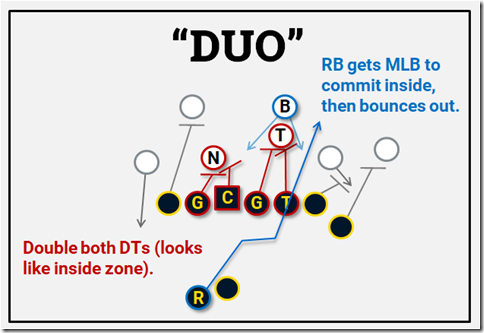
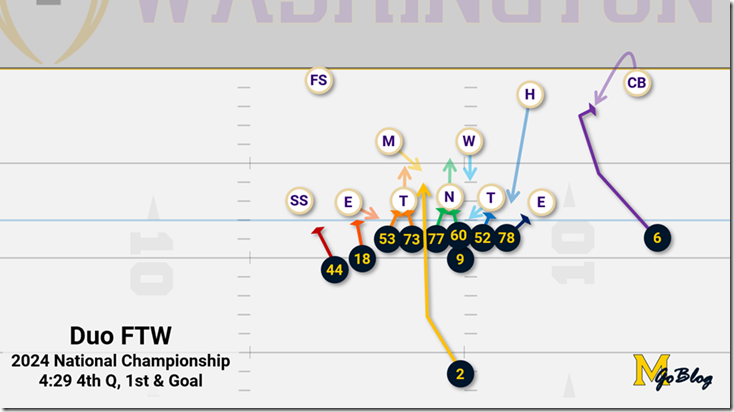
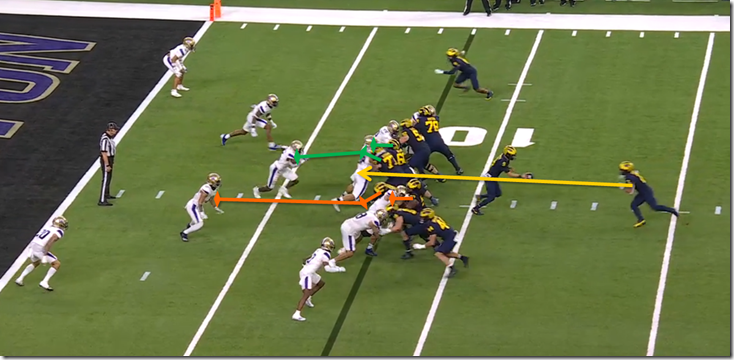
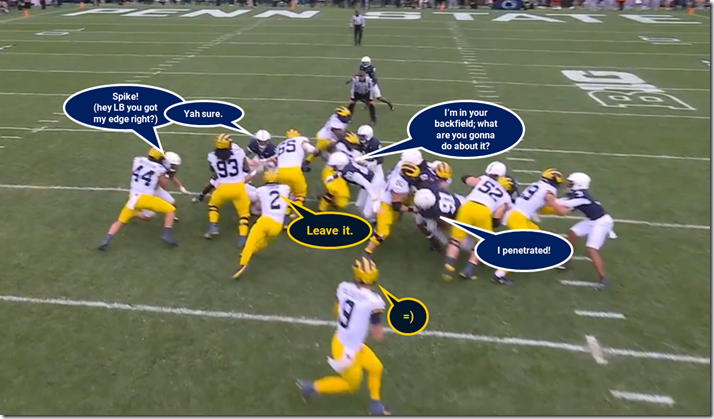

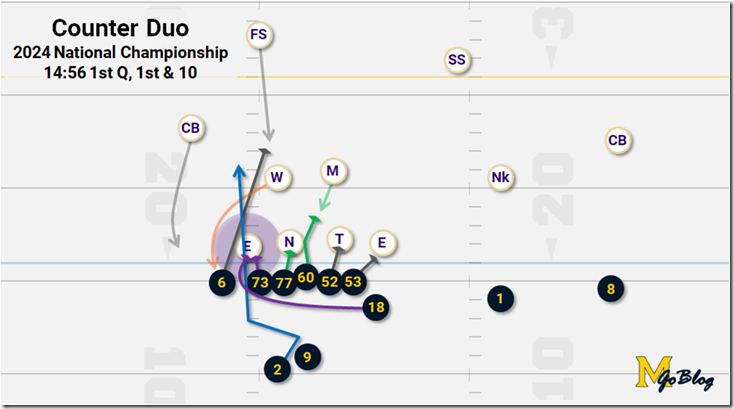
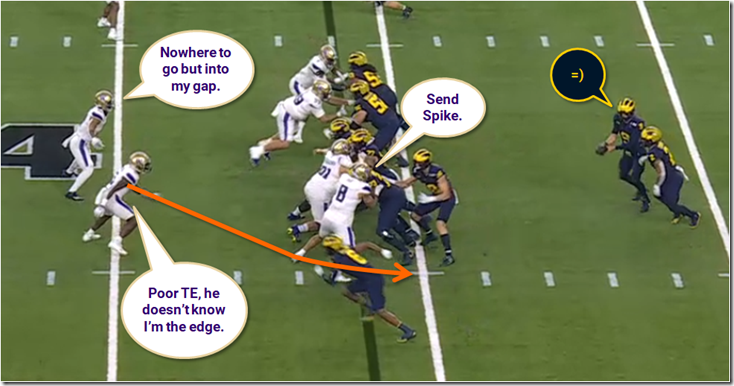

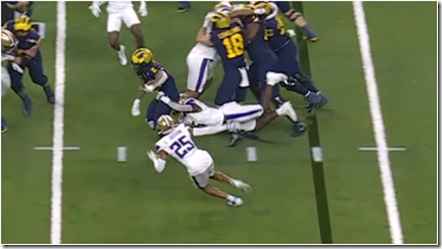
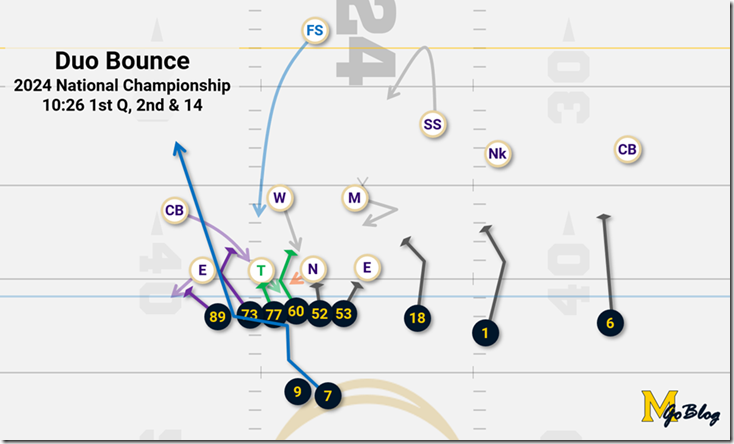
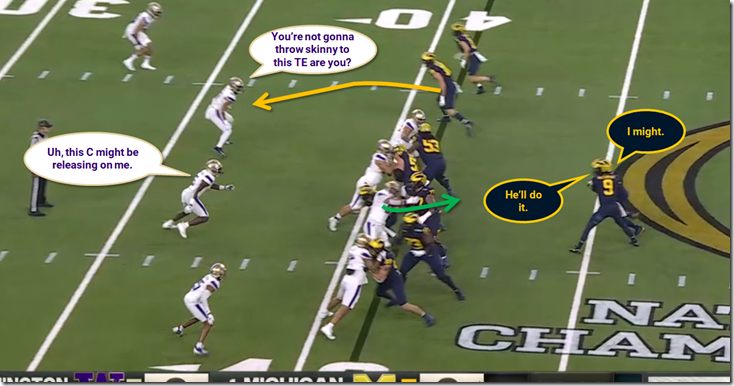
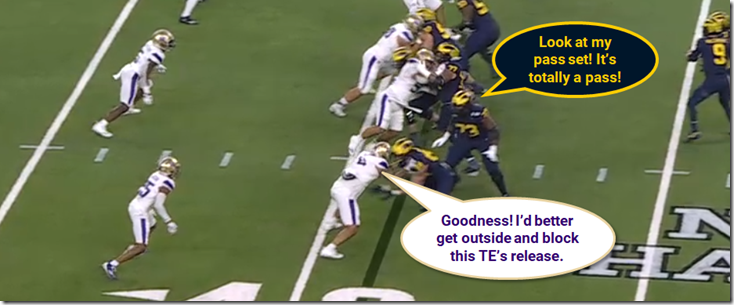

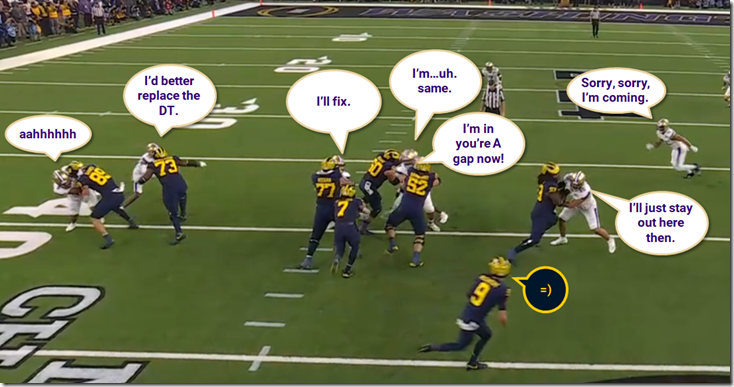
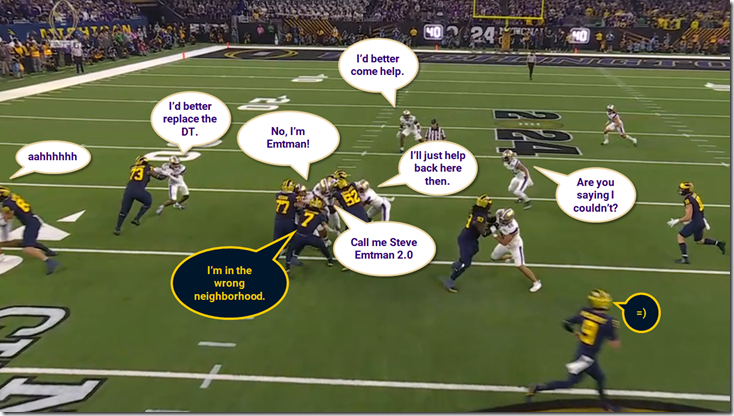
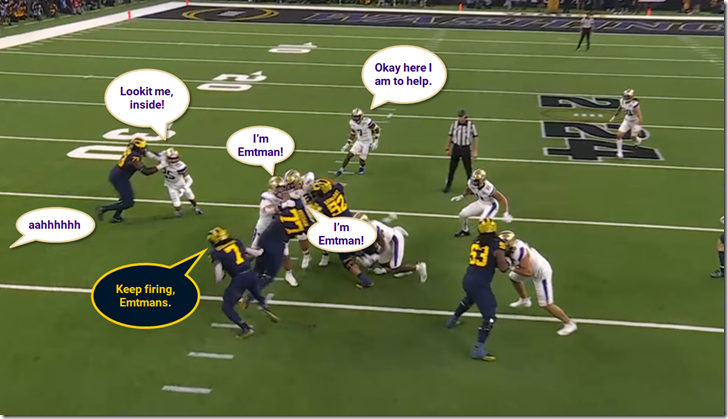
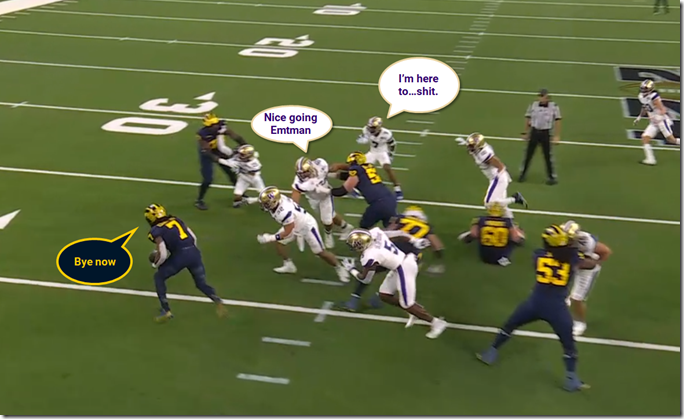
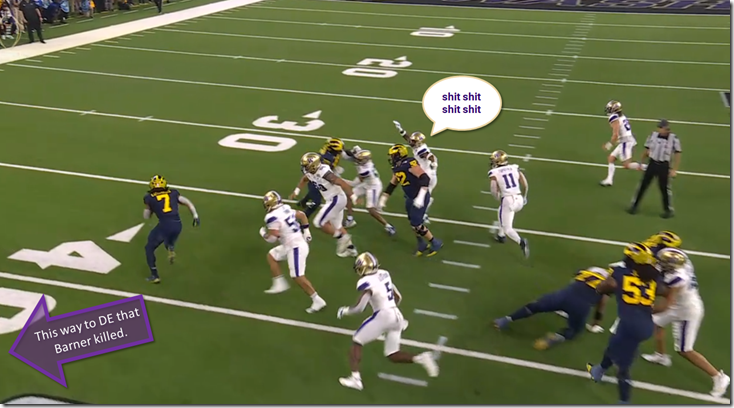
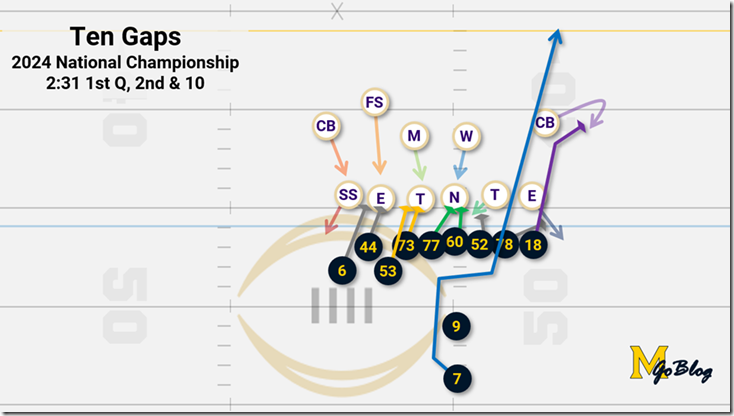

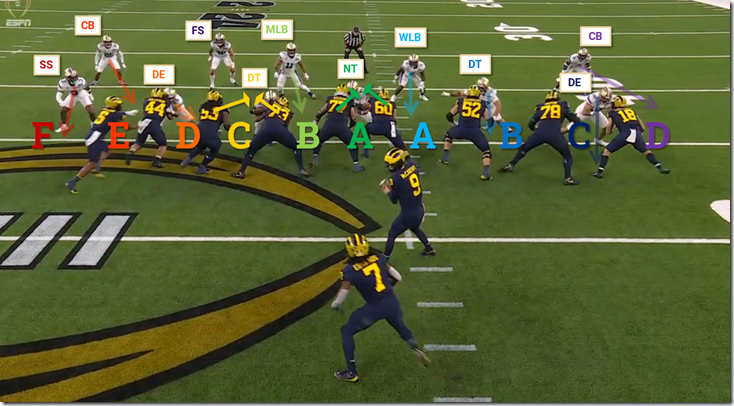
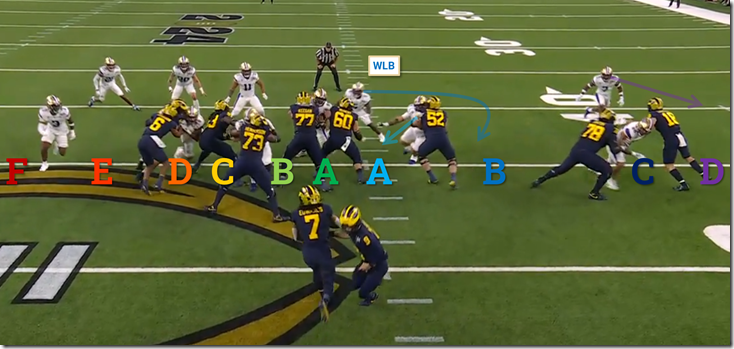
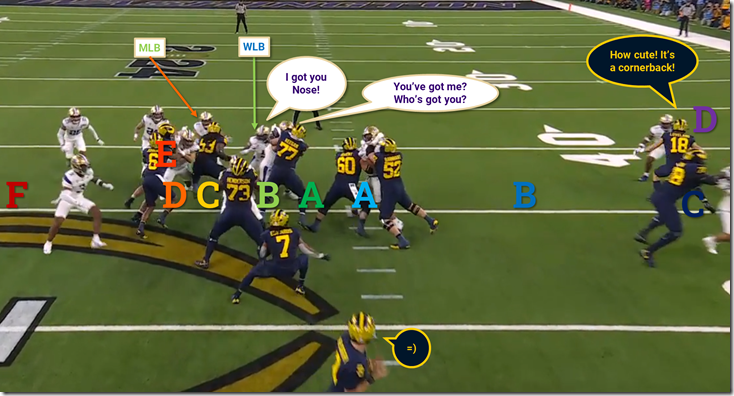
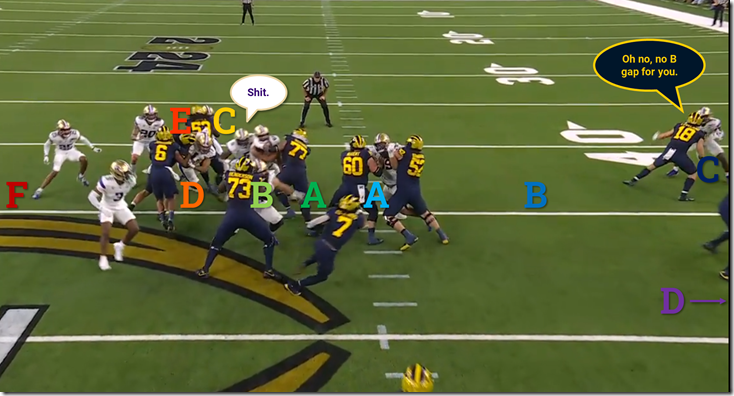
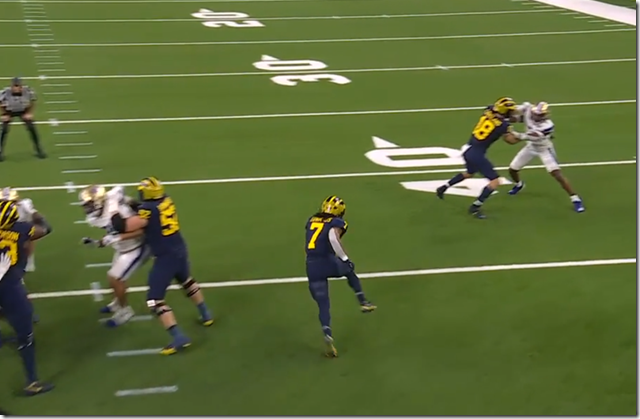
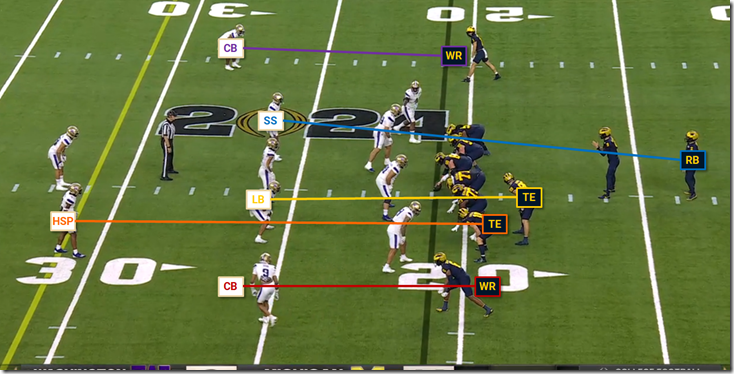
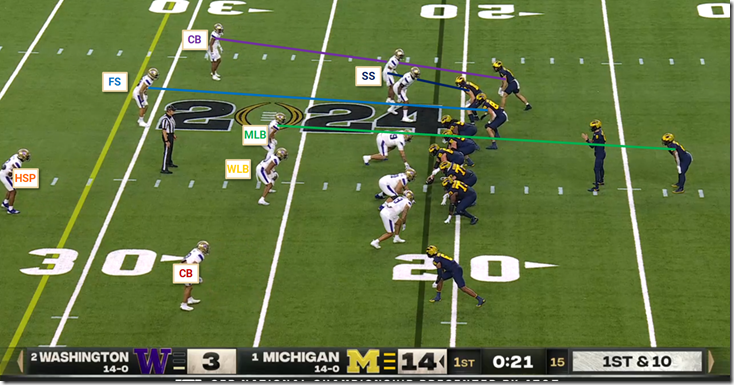

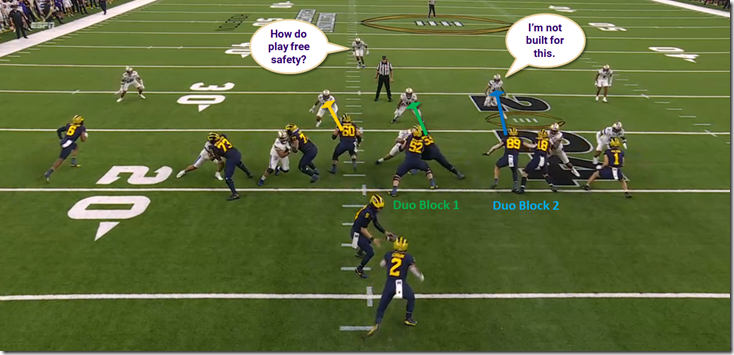
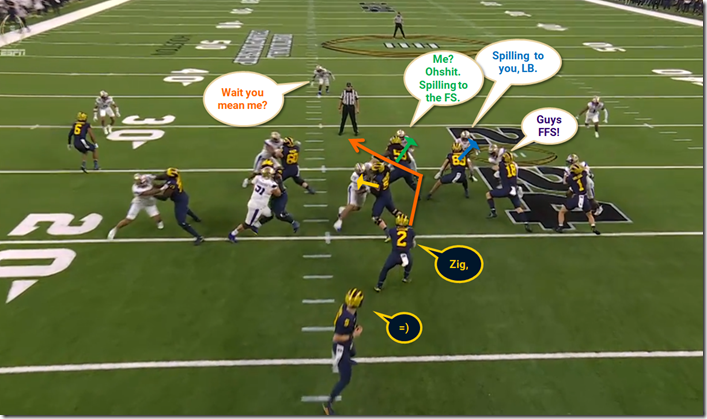
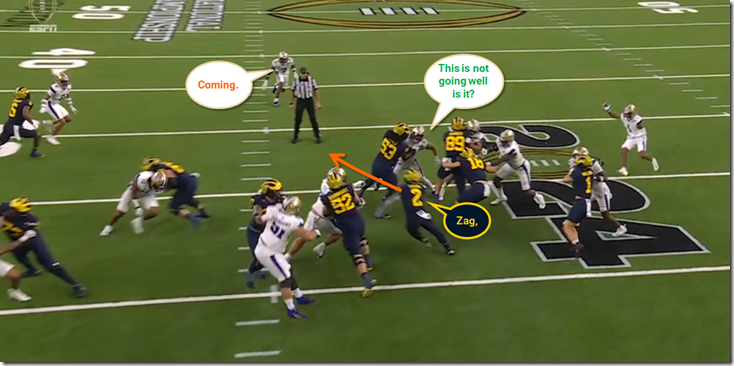
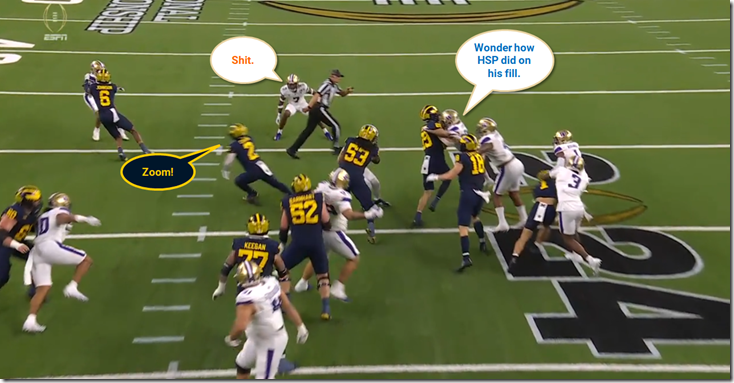
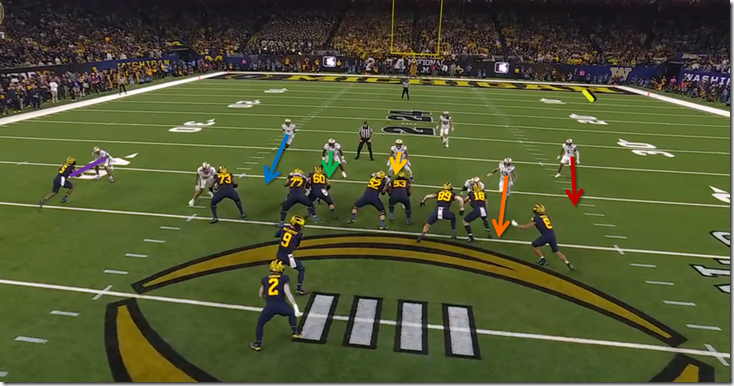
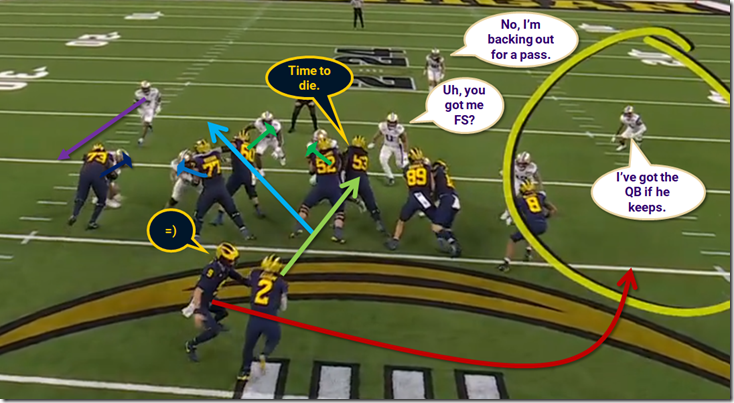
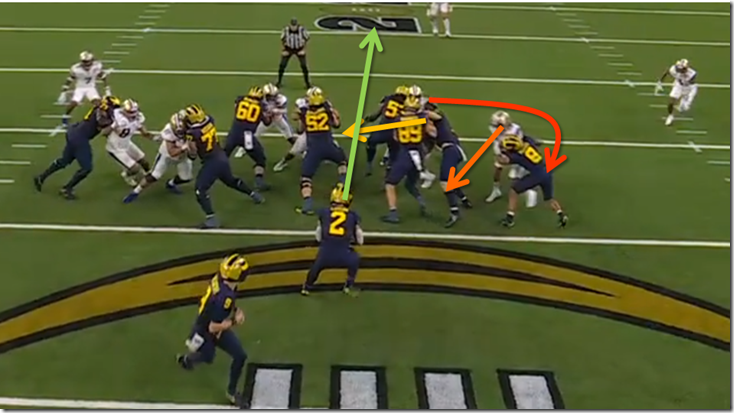
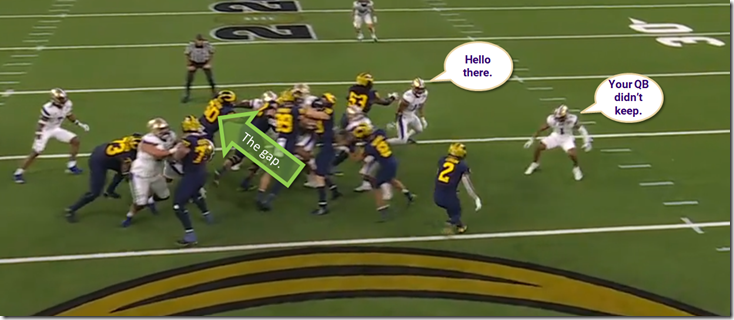
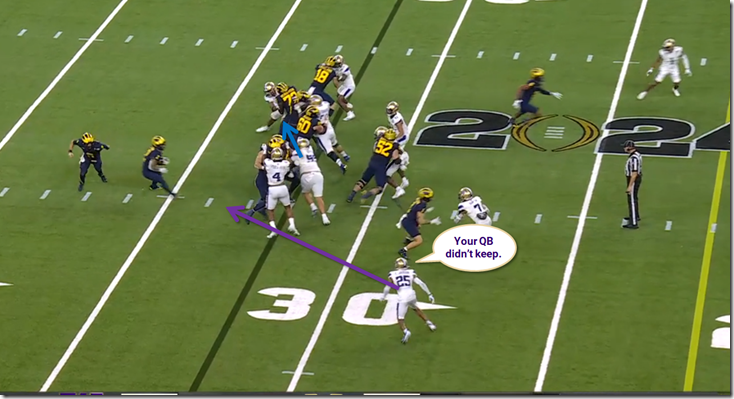
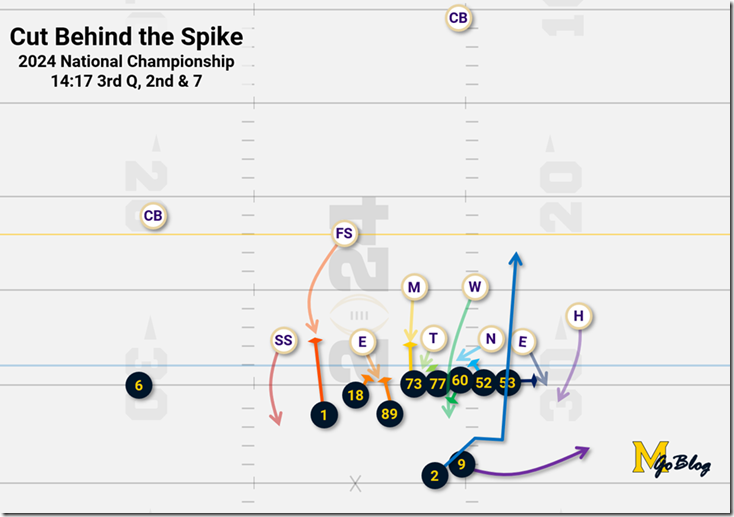
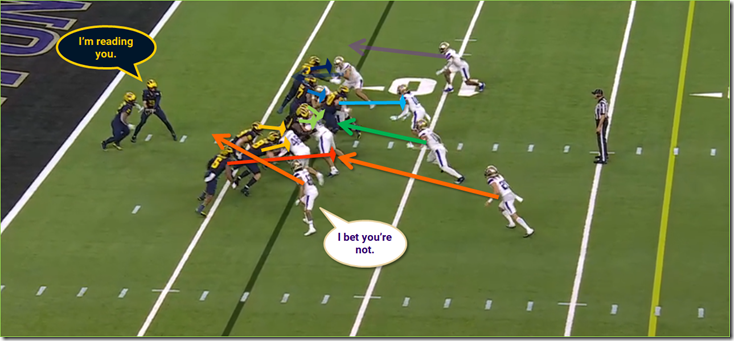
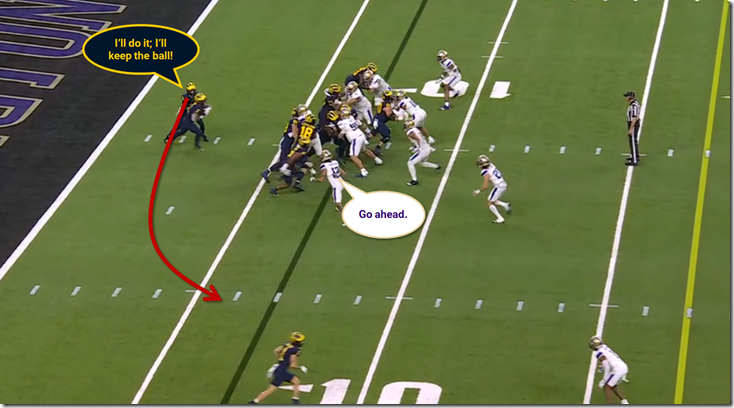
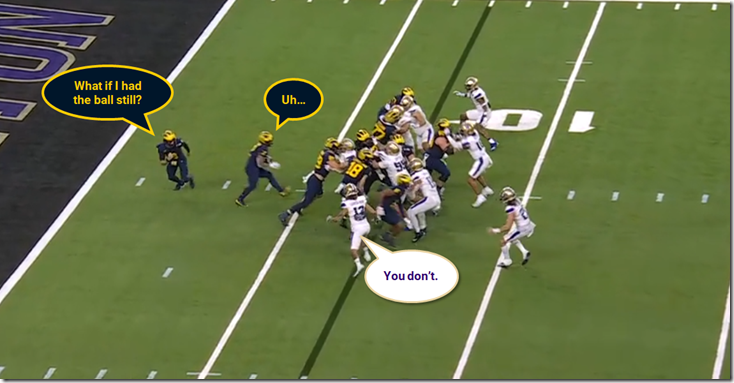
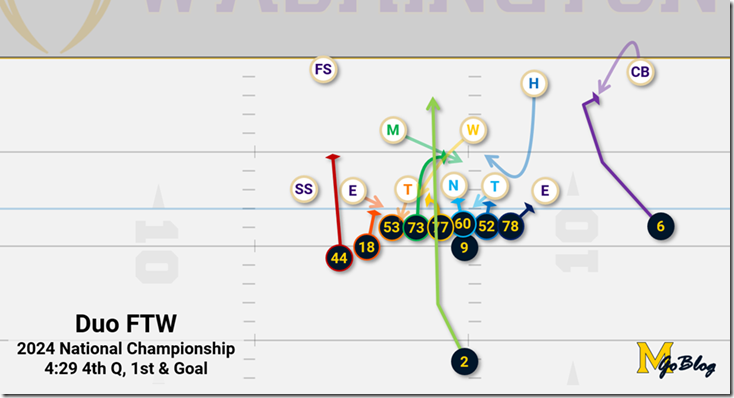
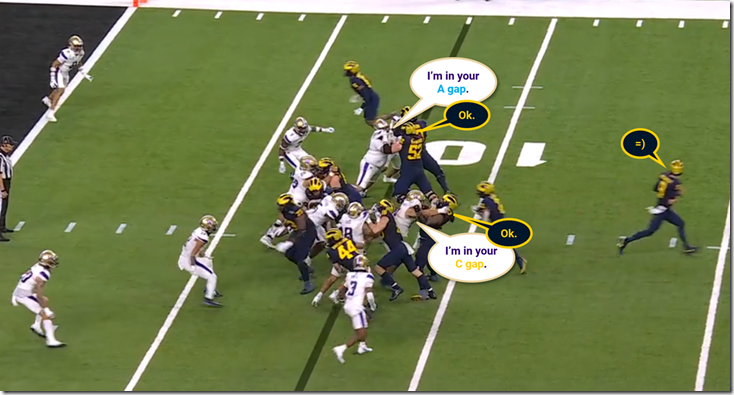
Comments